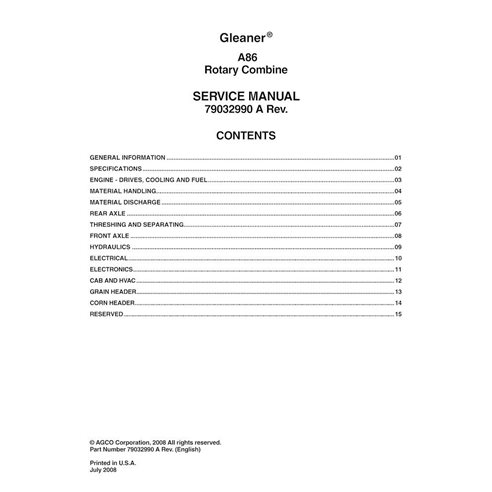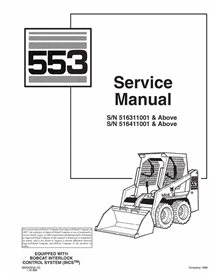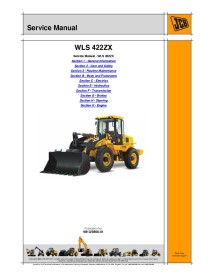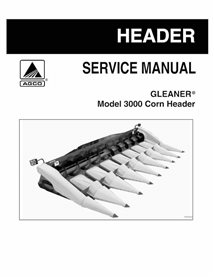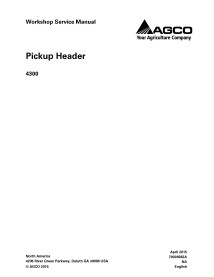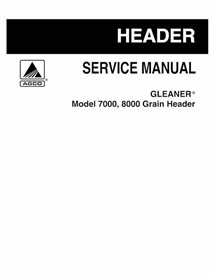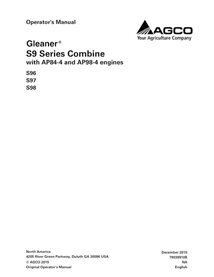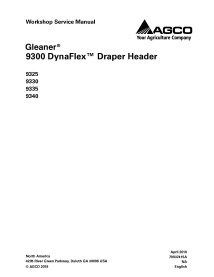Gleaner A86 combine pdf service manual
Format: PDF
Pages: 3396
File size: 292.92 MB
Language: English
Models: A86
Gleaner A86 combine pdf service manual is available for download in the customer's account on the website after the purchase. You can get an initial part of the manual using the link to a preview PDF file in the Attachments TAB. After reviewing you decide, if this manual is right for you. The file almost always contains bookmarks, by which you can evaluate the content of the manual. This fragment of the manual contains from 10 to 50 pages, what is quite enough to check the quality of the manual's content.
A service manual for Gleaner A86 is a virtual product in digital formats such as PDF that provides detailed information and instructions on how to maintain, repair, and troubleshoot a particular product or equipment. It typically contains technical specifications, diagrams, procedures, and other relevant information that are essential in servicing the product.
Service manuals provide a comprehensive and structured approach to servicing a product, helping technicians to identify and diagnose problems, perform repairs, and ensure that the product is operating correctly. They may also include safety precautions and guidelines to prevent accidents and ensure compliance with relevant regulations.
Overall, combine service manuals are an essential tool for technicians and professionals involved in maintaining and repairing complex products, providing them with the necessary information and guidance to ensure that the product operates safely and effectively over its lifetime.
The Gleaner Manufacturing Company is an American manufacturer of combine harvesters. Gleaner has been a popular brand of combine harvester particularly in the Midwestern United States for many decades, first as an independent firm, and later as a division of Allis-Chalmers. The Gleaner brand continues today under the ownership of AGCO.
Gleaner combines date from 1923, when the Baldwin brothers of Nickerson, Kansas, created a high-quality and reliable self-propelled combine harvester. They decided to use the "Gleaner" name for their radically redesigned grain harvesting machine based on inspiration from "The Gleaners", an 1857 painting by Jean-François Millet. Gleaning is the act of collecting leftover crops from farm fields after they have been commercially harvested, or on fields where it is not economically profitable to harvest. In the broadest sense, it is the act of frugally recovering resources from low-yield contexts. Thus, with the Gleaner name, the company evoked a positive connotation in potential customers' minds, of a brand of harvester that would leave none of the grain behind. A combine harvester combines the reaping (plus or minus binding), threshing, and winnowing functions into one machine, hence the "combine" part of its name. To that list, the Baldwin brothers' Gleaner added self-propulsion. Earlier combines, the so-called pull-type or tractor-drawn combines, were towed by tractors.
The original Gleaner design was mounted on a Fordson Model F. It had a retail price of $950 FOB at the factory in Nickerson. This design was manufactured between 1923 and 1928.
The Gleaner was one of the pioneers in self-propelled combines. They were often considered the "Cadillac" of the industry because of this feature and because of their solid engineering. Buescher (1991) credited the design principally to one of the brothers, Curt Baldwin, and explained that it focused on the needs of custom cutters like the Baldwin brothers themselves: contractors who move north with the harvest season, providing harvesting services to farmers. It resulted in machines that were reliable and useful, which benefited not only custom cutters but anyone who bought a Gleaner. The short wheelbase and axle track allowed the combine to fit on a truck. The grain header did not need to be detached for transit, because it fits over the cab of the truck. Buescher said, "Since custom cutters didn't know where their next parts supply source would be, Baldwin designed his combine so that it wouldn't need parts." The frame was "like a bridge" in its strength. The bearings were chosen with service in mind: large and good quality (to obviate failure) and of common sizes (so that the operator could carry a small stock of spares in his truck, and have the size needed when a replacement became necessary). The Gleaner's exterior sheet metal was galvanized (zinc plated), providing superior weather resistance. As Buescher said, "Baldwin reasoned that most of his combines would sit outdoors. Texas and Oklahoma dust storms have a way of peeling paint off of machinery." As a result of the silver color of the zinc plating, the Gleaner brand ended up having a distinctive color (just as Allis had Persian Orange, IH had red, and John Deere had green), despite the sheet metal not even having any paint.
During the Great Depression, owing mostly to the collapse of the farm economy and the Dust Bowl, the Baldwins' company entered bankruptcy in the 1930s as equipment sales plummeted. William James Brace acquired the company with his son-in-law, George Reuland. The pair, along with other investors, brought the company back to profitability and maintained ownership until 1955. During World War II, the factory converted its production to war materiel.
By the late 1940s and early 1950s, other farm equipment manufacturers were offering increased competition to Gleaner, having introduced their versions of self-propelled combines.
In 1955, Allis-Chalmers acquired Gleaner. This represented commercial renewal for Gleaner with the production and marketing success of various new models and technologies. It also represented a great gain for Allis-Chalmers. Allis was the market leader in pull-type (tractor-drawn) combines, with its All-Crop Harvester line. Acquiring Gleaner meant that it would also be a leader in self-propelled machines, and it would own two of the leading brands in combines. The Gleaner line augmented (and later superseded) the All-Crop Harvester line, and for several years Gleaner's profits made up nearly all of Allis-Chalmers' profit.[2] Gleaners continued to be manufactured at the same factory, in Independence, Missouri, after the acquisition.
1965 Gleaner E harvester
In 1979, Gleaner released its first rotary combine, the N6. It was soon followed by the N5 and N7. The latter was the largest combine of its time, with grain headers as wide as 30 feet (9.1 m).
In 1985, Allis-Chalmers sold their farm machinery manufacturing business to Deutz AG and became known as Deutz-Allis, and in 1991 its North American operations became AGCO. Despite several ownership changes, the Gleaner brand never ceased to be produced or marketed. Between 1985 and 2000, Gleaner lost significant market share to other manufacturers with broader dealer bases and farm equipment product lines that had marketing and customer service advantages. Another problem for Gleaner was that some of their combines used the air-cooled Deutz engine, a departure from water-cooled engines predominantly found in most other industrial and agricultural applications.
In 2000, AGCO moved the Gleaner manufacturing operations from Independence, Missouri to its Hesston, Kansas facility, which featured modernized manufacturing equipment and techniques. It also centralized the engineering and production functions into one location. The Hesston facility is 35 miles east of Nickerson, Kansas, where the Baldwin brothers started the Gleaner company in 1923.
In 2000, AGCO moved the Gleaner manufacturing operations from Independence, Missouri to its Hesston, Kansas facility, which featured modernized manufacturing equipment and techniques. It also centralized the engineering and production functions into one location. The Hesston facility is 35 miles east of Nickerson, Kansas, where the Baldwin brothers started the Gleaner company in 1923.
Some of the firsts introduced by the Gleaner were: an auger that replaced canvas drapers, a rasp bar threshing cylinder instead of a spike-tooth arrangement, and a down-front cylinder that put threshing closer to the crop. In 1972 Gleaner was the first manufacturer to use electro-hydraulic controls, an innovation that other companies didn't offer until nearly two decades later. Gleaner was also the first in the industry to offer a 12-row corn head in 1979.
Gleaner also explored the use of turbocharged diesel engines before the competition. Records from October 1962 list the 262-cubic-inch turbo-diesel engine as being available for the model "C".
Another Gleaner innovation was a "rock door" to protect the machine from damage due to stones that it might pick up while harvesting. If a Gleaner combine ingests a rock, the rock door simply pops open and drops the stone on the ground, preventing damage to the cylinder and concave bars, unlike other machines with a "rock trap" that the operator must periodically cleanout or dump.
A current Gleaner and world-first are that they created the first Class VIII transverse rotor combine. This happened when AGCO introduced the new Gleaner S88 series combine in 2014.
Gleaners are still in production under AGCO. The Gleaner brand is marketed in North America, South America, and Australia.
The two models that have been currently available, and in production since 2011, are the S67 and S77, which are Class VI and VII combines, respectively. Three newer models have come out this year (2016) and are now available and in full production, which are the S96, S97, and S98, which are Class VI, VII, and VIII combines, respectively. These combines still utilize the transverse rotor which was originally introduced in 1979.
